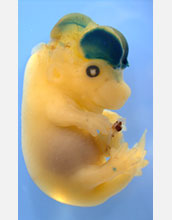Multimedia Gallery
Evolving a bigger brain with human DNA
The human version of a DNA sequence, called HARE5, turns on a gene important for brain development (the gene activity is stained blue in this image) and causes a mouse embryo to grow a 12 percent larger brain by the end of pregnancy than an embryo injected with the chimpanzee version of HARE5.
More about this image
The size of the human brain expanded dramatically during the course of evolution, giving us the ability to use abstract language and do complex math. But how did the human brain get larger than that of our closest living relative, the chimpanzee, if almost all of our genes are the same?
Scientists at Duke University, in an effort to find an answer to this question, have shown
that it’s possible to pick out key changes in the genetic code between chimpanzees and humans and then visualize their respective contributions to early brain development by using mouse embryos.
The team found that humans are equipped with tiny differences in a particular regulator of gene activity, dubbed HARE5, that when introduced into a mouse embryo, led to a 12 percent bigger brain than in the embryos treated with the HARE5 sequence from chimpanzees.
These findings may lend insight into not only what makes the human brain special but also why people get some diseases, such as autism and Alzheimer’s disease, whereas chimpanzees do not.
This research was supported in part by the National Science Foundation (grant BCS 08-27552).
To learn more, see the NSF News From the Field story Evolving a bigger brain with human DNA. (Date image taken: January 2015; date originally posted to NSF Multimedia Gallery: Jan. 25, 2017)
Credit: Deborah Silver lab, Duke University
Images and other media in the National Science Foundation Multimedia Gallery are available for use in print and electronic material by NSF employees, members of the media, university staff, teachers and the general public. All media in the gallery are intended for personal, educational and nonprofit/non-commercial use only.
Images credited to the National Science Foundation, a federal agency, are in the public domain. The images were created by employees of the United States Government as part of their official duties or prepared by contractors as "works for hire" for NSF. You may freely use NSF-credited images and, at your discretion, credit NSF with a "Courtesy: National Science Foundation" notation.
Additional information about general usage can be found in Conditions.
Also Available:
Download the high-resolution TIF version of the image. (6.7 MB)
Use your mouse to right-click (Mac users may need to Ctrl-click) the link above and choose the option that will save the file or target to your computer.

